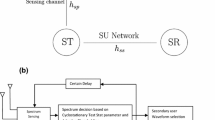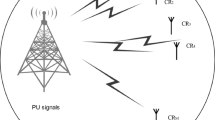Abstract
In cognitive radio (CR), cognitive users can sense the wholes and white spectrum and generate spectrum notch in the spectrum bands occupied by primary users (PUs) or interference. Thus, the key technology in CR is to control the spectrum shape of the transmitted signal to avoid PUs and interference. In this paper, a new method of shaping the transmitted signal spectrum envelope by spectrum-spread technology is proposed. The proposed method can generate spectral nulls at the band of PUs or interference in the CR environment. Compared to the existing methods generating spectrum nulls, the proposed method can effectively generate spectral nulls to avoid interference or PUs only by designing the pseudo-random code waveform (PCW) based on direct sequence spread spectrum technology. The condition of electromagnetic spectrum occupation is detected by CR technology so as to construct an ideal spectrum template. Based on the spectrum template, we study the design of the baseband waveform. The bit error rate (BER) performance of the proposed method in different sorts of interferences, and the relation between the BER and the spectrum overlap degree (SOD) are derived, of which the concept of SOD is proposed. The expression between BER and SOD shows that BER is proportional to SOD, which shows the criterion to design the PCW. The signal spectrograms in the receiver in presence of tone jamming and BPSK jamming indicate that the proposed scheme can effectively generate spectrum nulls in the frequency band occupied by PUs or interference. Furthermore, the BER versus SNR and BER versus SIR simulation results both in presence of tone jamming and BPSK jamming show that the proposed method has a significantly improved the BER performance by generating spectral nulls to avoid PUs or interferences. Simulation results are carried out to corroborate our theoretical analysis.






Similar content being viewed by others
References
Haykin, S. (2005). Cognitive radio: Brain-empowered wireless communications. IEEE Journal on Selected Areas in Communications, 23(2), 201–220.
Lin, Y., Liu, K., & Hsieh, H. (2013). On using interference-aware spectrum sensing for DSA in CR networks. IEEE Transactions on Mobile Computing, 12(3), 461–474.
Zhang, S., Dong, X., Bao, Z., & Zhang, H. (2013). Adaptive spectrum sensing algorithm in cognitive ultra-wideband systems. Wireless Personal Communications, 68, 789–810.
Mir, U., Merghem-Boulahia, L., Esseghir, M., & Gaïti, D. (2014). A multiagent based scheme for unlicensed spectrum access in CR networks. Wireless Personal Communications, 79, 1765–1786.
Backens, J., Xin, C., Song, M., & Chen, C. (2015). DSCA: Dynamic spectrum co-access between the primary users and the secondary users. IEEE Transactions on Vehicular Technology, 64(2), 668–676.
Datla, D., Rajbanshi, R., Wyglinski, A., & Minden, G. (2009). An adaptive spectrum Sensing architecture for dynamic spectrum access networks. IEEE Transactions on Wireless Communications, 8(8), 4211–4219.
Pandey, G. P., Kanaujia, B. K., Gupta, S. K., & Gautam, A. K. (2015). A novel C shape antenna with switchable wideband frequency notch. Wireless Personal Communications, 80, 471–482.
Badamchi, B., Nourinia, J., Ghobadi, C., & Shahmirzadi, A. (2014). Design of compact reconfigurable ultra-wideband slot antenna with switchable single/dual band notch functions. IET Microwaves, Antennas and Propagation, 8(8), 541–548.
Naser-Moghadasi, M., Sadeghzadeh, R. A., Asadpor, L., Soltani, S., & Virdee, B. S. (2010). Improved band-notch technique for ultra-wideband antenna. IET Microwaves, Antennas and Propagation, 4(11), 1886–1891.
Weiss, T. A., & Jondral, F. K. (2004). Spectrum pooling: An innovative strategy for the enhancement of spectrum efficiency. IEEE Radio Communications, 42(3), S8–S14.
Zhou, X., Li, G., & Sun, G. (2013). Multiuser spectral precoding for OFDM-based cognitive radio systems. IEEE Journal on Selected Areas in Communications, 21(3), 345–352.
Kumar, R., & Tyagi, A. (2014). Antiphase tones across transmitting antennas: A spectrum sharing technique for cognitive CO-STFC MB-OFDM UWB system. Wireless Personal Communications, 79, 437–451.
Kumar, R., & Tyagi, A. (2015). Extended subcarrier weighting for sidelobe suppression in OFDM based cognitive radio. Wireless Personal Communications,. doi:10.1007/s11277-015-2623-8.
Xiong, H., Zhang, W., Du, Z., He, B., & Yuan, D. (2013). Front-end narrowband interference mitigation for DS-UWB receiver. IEEE Transactions on Wireless Communications, 12(9), 4328–4337.
Mirzaee, M., Noghanian, S., & Virdee, B. S. (2014). High selectivity UWB bandpass filter with controllable bandwidth of dual notch bands. Electronics Letters, 50(19), 1358–1359.
Shao, H., & Beaulieu, N. (2011). Direct sequence and time-hopping sequence designs for narrowband interference mitigation in impulse radio UWB systems. IEEE Transactions on Communications, 59(7), 1957–1965.
Andren, C. F., Lucas, L. V., & Schachte, J. A. (1991). Low probability of intercept communication system. US Patent 5029184, July 1991.
Chakravarthy, V., Nunez, A., & Stephens, J. (2005). TDCS, OFDM, and MC-CDMA: A brief tutorial. IEEE Radio, Communications, 43(9), S11–S16.
Budiarjo, I., Nikookar, H., & Ligthart, L. (2008). Cognitive radio modulation techniques. IEEE Signal Processing Magazine, 25(6), 24–34.
Chakravarthy, V., Li, X., Wu, Z. Q., et al. (2009). Novel overlay/underlay cognitive radio waveforms using SD-SMSE framework to enhance spectrum efficiency—Part I: theoretical framework and analysis in AWGN channel. IEEE Transactions on Communications, 57(12), 3794–3804.
Lin, R., Bi, G., Liu, X., & Guan, Y. L. (2014). On the modulation and signalling design for a transform domain communication system. IET Communications, 8(16), 2909–2916.
Hu, S., Guan, Y. L., Bi, G., & Li, S. (2012). Cluster-based transform domain communication systems for high spectrum efficiency. IET Communications, 6(16), 2734–2739.
Bernard, S. (2001). Digital communications: Fundamental and applications (2nd ed., p. 19). Upper Saddle River: Prentice Hall PTR.
Schilling, D. L., Milstein, L. B., Pickholtz, R. L., et al. (1980). Optimization of the processing gain of an M-ary direct sequence spread spectrum communication system. IEEE Transactions on Communications, COM, 28(8), 1389–1398.
Acknowledgments
This work was supported by the National Natural Science Foundation of China (Grant No. 61271263).
Author information
Authors and Affiliations
Corresponding author
Appendices
Appendix 1
where
Therefore we can obtain that
Appendix 2
Appendix 3
When there is interference in the communication system, we can obtain thatr(t) ∼ N(I(t) − AE PN , n 0 E PN ) for the case where 0 is sent and r(t) ∼ N(I(t) + AE PN , n 0 E PN ) for the case where 1 is sent. We can obtain that
Appendix 4
Let Δω = ω I − ω 0, then
Similarly we can obtain that
Therefore, we can obtain that
Appendix 5
where denotes complex conjugate.
Appendix 6
When we analyze I(t), it shows the correlation value of PN(t) cos ω 0 t and i(t). For real signal i(t), when i(t) = PN(t) cos ω 0 t, I(t) obtains the maximum value
Then \(\frac{I\left( t \right)}{{2E_{b} }}\) reaches the maximum value 1. When \(i\left( t \right) = { - }PN\left( t \right)\cos \omega_{0} t\), I(t) obtains the minimum value and
Then \(\frac{I\left( t \right)}{{2E_{b} }}\) attains the minimum value −1.
Appendix 7
where \(erfc\left( x \right) = \frac{1}{\sqrt 2 }\int_{x}^{\infty } {\exp \left( { - {\text{z}}^{2} } \right){\text{dz}}}\).
For simplify and without loss of generality, set k equal to \(\sqrt {{{E_{b} } \mathord{\left/ {\vphantom {{E_{b} } {n_{0} }}} \right. \kern-0pt} {n_{0} }}}\) and (39) can be rewritten as
Take the derivative of (40) we can achieve that
(41) shows that when SOD > 0, \(\frac{{{\text{d}}P_{e} }}{{{\text{d}}SOD}} > 0\) ;when SOD = 0, \(\frac{{{\text{d}}P_{e} }}{{{\text{d}}SOD}} = 0\) ;when SOD ≤ 0, \(\frac{{{\text{d}}P_{e} }}{{{\text{d}}SOD}} < 0\). Thus, P e can get the minimal value when SOD = 0.P e is proportional to SOD when SOD > 0.
Rights and permissions
About this article
Cite this article
Guo, L., Li, Q., Gao, F. et al. A New Method of Generating Spectral Nulls at the Transmitter in Cognitive Radio. Wireless Pers Commun 88, 819–837 (2016). https://doi.org/10.1007/s11277-016-3207-y
Published:
Issue Date:
DOI: https://doi.org/10.1007/s11277-016-3207-y




